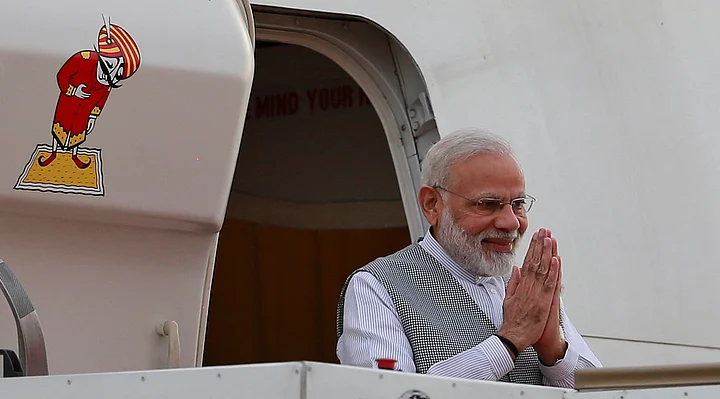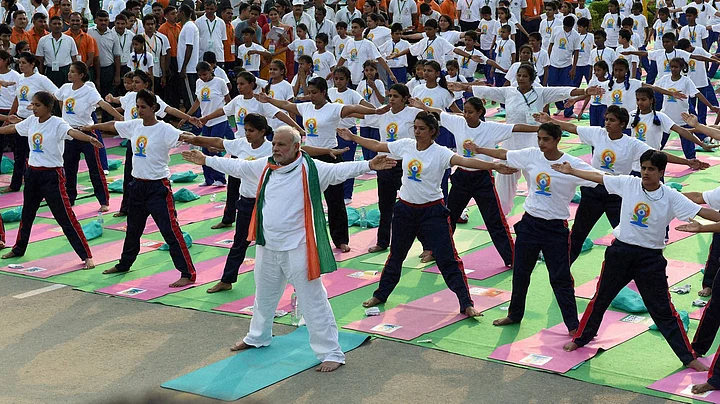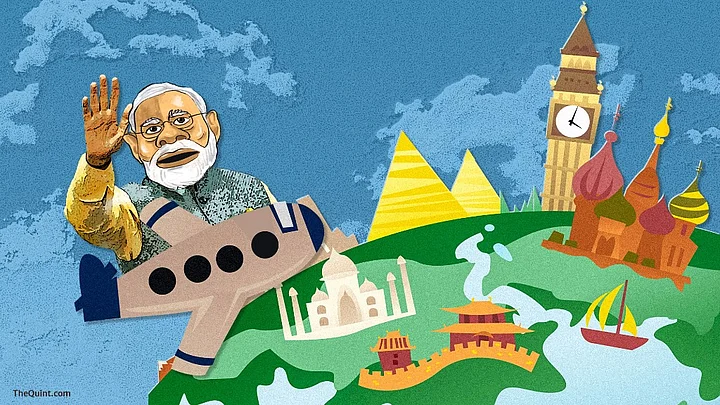When the Bharatiya Janata Party (BJP) in India came to power in a landslide victory in May 2014 under the leadership of Narendra Modi, both domestic and foreign observers of India’s foreign policy had a limited conception of Modi and the BJP’s approach with regard to India’s external engagements. However, people of India entrusted the BJP, under the leadership of Modi, with a mandate for change.
After a long period, India has a single party majority government. So, the Modi government is not working under coalition compulsions. Pro-active leadership of Modi has terrifically transformed India’s external affairs. Delivering the 37th Singapore Lecture on 23 November 2015, captioned as ‘India’s Singapore Story’, during his visit to the country, PM Modi remarked:
The wheels of change are moving; confidence is growing; resolve is stronger; and, the direction is clearer.
This clearly manifests a shift in broader ideas and approach to India’s external affairs, and undoubtedly a departure from the past.
Indeed, Modi is a very energetic and active leader, and he seems to be acquiring a solid domestic political support for an effective pursuit of India’s external relations through his profound communication skills, which is vital for any big country.
Modi has demonstrated his political will for India’s global engagements through continuous, frequent and sustained interactions with the world.

Modi’s outlook on global affairs retains the main thrust of India’s approach to the world, yet there is a nuanced aim of linking India’s foreign policy to domestic transformation under his leadership.
While his policies are designed to attract foreign capital and technology, and seek foreign markets for Indian products, they are also geared towards a closer linkage of regional stability, peace and prosperity. India’s foreign policy under Modi demonstrates a marked change and exceptional dynamism. Indeed, India is witnessing an emergence of the ‘Modi Doctrine’.
- India first: Modi’s foreign policy ‘is guided by the constant drive to reform and transform India, for security and prosperity of all Indians’.
- Neighbourhood first: Modi dreams of a ‘thriving well-connected and integrated neighbourhood’.
- Overcoming historic hesitations: The Modi government has strengthened India’s partnership with competing powers.
- From Rule-taker to Rule-maker: The government is willing to share responsibilities on important global issues.
- Indian Diaspora: The government has qualitatively and quantitatively enriched engagement with the Indian diaspora.
- Strengthening Cultural Ties: Modi has talked extensively on shared values, traditions and heritage and strengthened ancient ties.
Doctrine is not a definitive statement, rather, it is a way of seeing a departure from the past. The world is dynamic where frames of reference are shifting rapidly. In Modi’s foreign policy approach, we see a sense of a broader shift in ideas. There are several key features of the Modi Doctrine.
‘India First’
‘India First’ is the fundamental feature of the Modi Doctrine. India’s choices and actions are based on the strengths of its national power. Further, India’s strategic intent is shaped mainly by realism, co-existence, cooperation and partnership. Moreover, Modi’s foreign policy doesn’t fit a ‘hard nationalist script’ based on India’s military might and expansionism, rather it is guided by a core value of Vaasudhaiva Kutumbakam (the entire world is our family).
Focused on India’s development, Modi’s foreign policy ‘is guided by the constant drive to reform and transform India, for security and prosperity of all Indians’. In his inaugural address at second Raisina Dialogue in Delhi on 17 January 2017, Modi underlined that the economic and political rise of India “represents a regional and global opportunity of great significance. It is a force for peace, a factor for stability and an engine for regional and global prosperity”.
‘Neighbourhood First’
A determined ‘neighbourhood first’ approach denotes the second important feature of the Modi Doctrine. Modi dreams of a ‘thriving well-connected and integrated neighbourhood’ and hence, the current Indian government under Modi has clearly indicated India’s priority for building stronger ties with its neighbourhood.

Modi has shown his zeal and vigour in engaging neighbours at the highest political level, which could be seen as an effort to build a political connectivity. New Delhi is also actively engaging State governments in foreign policy manoeuvres and encouraging them to engage in a meaningful way.
Further, we are witnessing a tight integration of domestic and foreign policies leading to ‘a seamless continuum between India’s choices at home and its external engagements’.
Overcoming Historic Hesitations
The Modi government has become more decisive in overcoming the question of historic hesitation. Countries which were kept at a distance deliberately in the past have become more important. Therefore, overcoming the hesitations of history is the third key feature of the Modi Doctrine.
The Modi government has established good relationships, and has redefined and strengthened India’s partnership with competing powers, for instance, India’s simultaneous improvement in relations with Arabs and Israel.
From ‘Rule-Taker’ to ‘Rule-Maker’
Under the Modi Doctrine, there is a clear enunciation for India to drive and lead on global issues and the country seems prepared to play a leadership role on various issues of interest to the international community and humanity at large. India is shifting its gear from ‘rule-taker’ to ‘rule-maker’ and hence, to play a leadership role is the fourth key feature of the Modi Doctrine.
The Modi government is embracing a more proactive regional and global role in tune with India’s national power and is willing to share global burdens and responsibilities on important global issues.
Indian government is working closely with major powers and several regional and global institutions on issues of common interests for better policy coordination. These issues range from climate change, technological cooperation, pandemics, terrorism, skill development, trade and services agreements, energy security and many others.
Strengthening the Cultural Connect
Promotion of Indian values, culture and tradition or civilisational connect is the fifth important feature of the Modi Doctrine. PM Modi’s visits to cultural sites in Japan, China, Mongolia, Sri Lanka, Bangladesh etc., where ancient civilisational connections between India and these countries are still visible, is indeed noteworthy.
He has also talked extensively on shared values, traditions and heritage and therefore strengthened these ancient ties.
The Modi government had done a remarkable job through a rare display of its soft power diplomacy when the entire world along with the United Nations celebrated International Yoga Day on 21 June.

Modi’s other signature initiatives like the International Solar Alliance or social media campaigns like #selfiewithdaughter (to promote equality for girls and women) are good examples of soft power augmentation. Similarly, India is working on technological innovations in healthcare, traditional medicine, satellites for education and other developmental cooperation, and is sharing this knowledge with friends and partners.
Engagement With the Indian Diaspora
A very dynamic engagement with the Indian diaspora is the sixth key feature of the Modi Doctrine. The Modi government has qualitatively and quantitatively enriched engagement with the Indian diaspora, and is trying to simplify rules, quickly responding to their grievances, and engaging them in the overall development agenda of the government.
Indian government’s pro-active approach towards the diaspora community has re-energised the Non Residential Indians (NRIs) and Persons of Indian Origin (PIOs) community, strengthening their ties with their country of origin and enhancing their stature in their country of residence.

This is clearly evident in Modi’s interactions with the Indian community abroad through various means including public meetings and connection through social media. Such focused engagement could be very helpful in creating synergies for trade, investment, technology transfers, cultural exchange, and more importantly, in mobilising political support.
Digital diplomacy has become a very effective means of communication.
On occasions, diaspora community has approached the Ministry of External Affairs (MEA) for assistance and due to quick and direct communications, timely assistance has been facilitated by the government.
Modi, in his address at the Second Raisina Dialogue, has clearly outlined essential features of India’s external affairs – rebuilding connectivity in India’s immediate and extended geographies; shaping relationships networked with India’s economic priorities; making India a human resource power; building development partnership and creating Indian narratives on global challenges; helping to reconfigure, reinvigorate and rebuild global institutions and organisations, and to spread the benefits of India’s civilisational legacies as a global good.
Modi’s vision of Sab Ka sath, Sab Ka Vikas (take everyone along and work for everyone’s development) is ‘a belief for the whole world and it manifests itself in several layers, multiple themes and different geographies’.
(Rajeev Ranjan Chaturvedy is Research Associate at the Institute of South Asian Studies (ISAS), an autonomous research institute at the National University of Singapore. This is an opinion piece and the views expressed above are the author’s own. The Quint neither endorses nor is responsible for the same. )
(At The Quint, we question everything. Play an active role in shaping our journalism by becoming a member today.)
